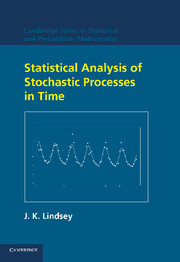Book contents
9 - Time series
Published online by Cambridge University Press: 03 February 2010
Summary
In this chapter, I shall begin the exploration of models for stochastic processes having a continuous state space rather than a small set of states. The best known case involves the classical time series models, used so widely in econometrics.
Traditionally, any series of numbers over time would be considered to be a time series and standard methods based on the normal distribution applied, perhaps after taking logarithms. As we have already seen in Sections 1.2 and 7.1, such an approach certainly is not generally recommended; modern methods are available based on more reasonable distributional assumptions. Exceptionally, I shall follow this classical approach in this chapter in order to illustrate how time series models are still often applied.
Much of time series analysis, especially in econometrics, involves tests of various hypotheses. Well known cases include the Durbin–Watson, Chow, and reset tests. Here instead, I shall concentrate on developing appropriate models for a series. Equivalent information to that from such tests can be obtained by comparing models, but much more can be learnt from modelling than from testing.
Descriptive graphical techniques
A variety of graphical methods is available for preliminary analysis of time series data.
Graphics
As with any stochastic process, the first thing to do with a time series is to produce appropriate informative plots. With a continuous response, a fundamental plot will show the series against time. Often, series are first standardised to have zero mean and unit variance, primarily to obtain better numerical stability. I shall not follow that practice here.
- Type
- Chapter
- Information
- Statistical Analysis of Stochastic Processes in Time , pp. 213 - 232Publisher: Cambridge University PressPrint publication year: 2004

